|
|

|
|
Author
|
Topic: Viking to Mars 1970-1975 astrophilately
|
Ken Havekotte
Member Posts: 2979
From: Merritt Island, Florida, Brevard
Registered: Mar 2001
|
 posted 11-15-2019 08:25 PM
posted 11-15-2019 08:25 PM
   
Coming up soon will be 50 years since the first Viking Mars Project postal covers started to appear. One of the first Viking Mission to Mars commemorative covers was in Oct. 1970 for a Mars chute test at NASA's Wallops Island, VA, even though the "parasol popping" rocket experiment was an early pre-Viking Mars proposal to land instruments on the Martian surface for the first time. The cachet cover, seen below at top row center, was produced by Ed Hacker's Centennial Covers of Huntsville, AL, a major space cover dealer that had been in operation for a few decades.If there are any earlier Viking Mars related cover issues in 1969-70, I would love to see them along with any other different pre-launch issues, but I have no covers noted before October 1970. While most Viking Mars pre-launch covers were produced between 1972-75 (before Aug. 20, 1975), 1971 was a mystery year with hardly no Viking covers on record to my knowledge. 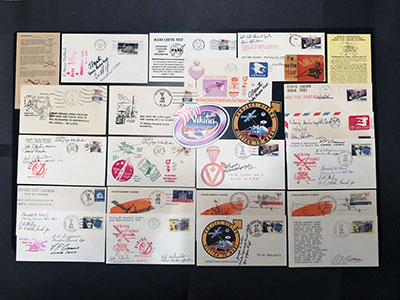 As an avid Viking Mars enthusiast and astrophilately collector since my high school teenage years, I've tried to collect just about anything I could get my hands on involving America's first soft-landings on the Red Planet in 1976 and even beforehand with the twin Viking launches and other events. Depicted here are two display panel presentations, but they're not Viking launch, Mars landing, flight control, or post-flight events. I'll leave those historic activities using highlight postal covers for a future display panel, perhaps one for the Viking A/B launches from the Cape and another for landing events and in-flight control related covers in a few months. I've got many to show with all of the covers signed along with several "one of a kind" issues. But for now, the few covers displayed here are of a limited representation of different cachet and cancel types, of which are only in commemoration of pre-launch events before the year-long Viking 1 flight to the Martian landing site area of Chryse was launched in Aug. 1975. 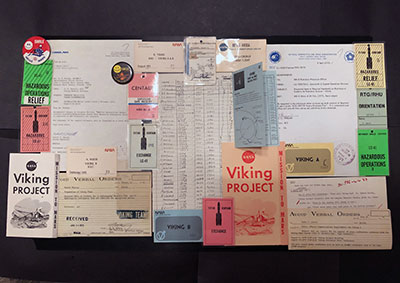 The second display panel, while not philatelic, consists of pre-launch Viking Mars memorabilia such as badges, early-issued brochures, pinback buttons, and original-era "working" papers. Included are a few KSC-NASA internal or "on base" working Viking letters and papers throughout 1974-75. One of the NASA work-project Viking letters, dated in April 1975, had been signed by D. C. Sheppard for providing a draft of a proposed Radiological Recovery Plan in case one of the Viking probes had a failure during launch. That same Viking official, as Chief of the Viking Orbiter and Lander spacecraft, KSC's Support Operations Division, even signed one of the above shown Viking spacecraft pre-launch covers in Feb. 1975, completely unrelated to his actual "work" content letter. As most of us know, the first Viking missions to land on Mars were perhaps one of NASA's greatest planetary efforts of the 1970's and even beyond. With a Mars launch opportunity during the summer of 1975, it was a perfect occasion to fly together orbiting spacecrafts and lander vehicles to the Red Planet in 1975-76, our nation's Bicentennial Year! With that first landing on July 20, 1976, after nearly half-a-billion mile journey from earth, it was a terrific "Spirit of '76" celebration for our country that not only put a spacecraft on Mars for the first time, but just seven years earlier on that same day, put American astronauts on the surface of the moon! The day was declared by President Nixon as "Space Exploration Day," and rightly so. |
Bob M
Member Posts: 1755
From: Atlanta-area, GA USA
Registered: Aug 2000
|
 posted 11-18-2019 04:45 PM
posted 11-18-2019 04:45 PM
   
Great pre-launch Mars covers and material, Ken, and what a great and exciting time it was back in 1976 when spacecraft were actually landing on Mars and sending back surface photos and data! Glad I experienced it all and was able to acquire some excellent material and autographs pertaining to the Viking Mars landings. Now landing on Mars almost seems routine but it wasn't back then and having both Viking spacecraft land successfully was an amazing accomplishment. We'll be looking forward to your next presentation highlighting Mars launch covers, and beyond. |
Ken Havekotte
Member Posts: 2979
From: Merritt Island, Florida, Brevard
Registered: Mar 2001
|
 posted 11-22-2019 06:47 AM
posted 11-22-2019 06:47 AM
   
Yes indeed, Bob, the 1970's was perhaps the second best decade for us space collectors. With Viking, as you know, we also had Apollo 13 and the last four Apollo lunar landings, the Skylab space station crew visits, Apollo-Soyuz, the incredible Pioneer 10-11/Voyager 1-2 deep spacecraft voyages, the Landsat series of Earth Resources Technology Satellite program, along with countless numbers of other space probe and satellite programs -- and not to mention the start or development of a new manned spaceflight program with the shuttle and NASA's biggest astronaut group selection. And how can we not forgot about all the exciting research flights from NASA's Dryden at Edwards AFB throughout that whole decade.Thanks for being a big part of that "collecting decade" with me, Bob, as we shared our collecting enthusiasm and passion while working together on so many of these exciting projects. It was a great time! |
cvrlvr99
Member Posts: 146
From: Arlington, TX
Registered: Aug 2014
|
 posted 12-12-2019 05:15 PM
posted 12-12-2019 05:15 PM
   
Ken, I have just over 200 Viking covers. Two different cachets for the parasol tests (Space Voyage and Sarzin) but no others for 1971 or 72. |
Rambler Typhoon
Member Posts: 29
From:
Registered: Dec 2015
|
 posted 01-09-2020 09:34 PM
posted 01-09-2020 09:34 PM
   
The Viking probe was one of the first projects to catch my interest as a kid. Still a favorite!I've seen some Viking covers with Star Wars themed cachets in a friend's collection and would love to track down some of those if anyone has a lead. |
Ken Havekotte
Member Posts: 2979
From: Merritt Island, Florida, Brevard
Registered: Mar 2001
|
 posted 01-11-2020 01:38 PM
posted 01-11-2020 01:38 PM
   
America and the world's first successful Mars landings were launched to the Red Planet 45 years ago in August and Sept. of 1975. Below is a new installment, Part 2 of 3, of Viking postal covers along with a launch team signed photo, a few Cape badges, and a couple of posted launch day brochures with combo-cancels for both launch and Martian landing. 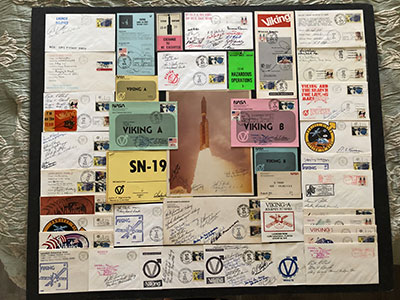 This part of the series only pertains to "launch day" Viking Mars autographed covers, for the most part, of both NASA/ U.S. Air Force Titan IIIE/Centaur missions. Most of the signatures depicted on the covers above represent the major Viking launch vehicle program agencies and contractor companies that took our nation to Mars so many decades ago. During the 1970's, the Titan IIIE launch vehicle was the most powerful unmanned rocket to fly, except for the Skylab-1/Saturn V that only flew once in 1973. The twin 160-foot high Viking Titan/Centaur vehicles were produced for the Air Force by Martin Marietta Aerospace in Denver, CO, which was also the booster integration contractor for the 3-stage Titan IIIE. The high-energy Centaur D-1T upper stage, that housed the Viking planetary probes at top, was built by General Dynamics in San Diego, CA. Several of the signed covers contain those Viking autographs of key Titan IIIE program officials and personnel teams from those locations across the country. The signatures of top NASA launch team and development folks are also represented nationwide, such as the Kennedy Space Center and the Cape Canaveral Air Force Station (with a pair of flown launch support helicopter covers), NASA's Lewis Research Center in Cleveland, OH, the Viking tracking of the Centaur and Mars spacecrafts from the Jet Propulsion Labs in Pasadena, CA, along with the Goldstone Space Communications Station at Barstow, CA, just to name a few of the major players. Many of the covers received Viking space agency and seldom-seen company rubber stamp cachets, along with some other markings, in commemoration of their proud Viking program participation. Look for them by Martin Marietta, the NASA space centers at Kennedy and Langley, and Goddard's Spaceflight Tracking and Data Network in Greenbelt, MD. The final segment of highlight Viking Mars philatelic covers and other related memorabilia will focus on the actual Mars orbital and landings themselves in 1976. The best is yet to come, meanwhile, let's see some other Viking launch covers. |
Ken Havekotte
Member Posts: 2979
From: Merritt Island, Florida, Brevard
Registered: Mar 2001
|
 posted 03-13-2020 09:16 AM
posted 03-13-2020 09:16 AM
   
Though only a few months shy of the first U.S. Mars landing 44 years ago on July 20, 1976, below is the third and final segment in an astrophilately tribute of the first time that a spacecraft had successfully soft landed and operated on the planet Mars. Not once, but twice, in the same year only six weeks apart from one another.The one-billion dollar Viking program was America's most ambitious unmanned space venture. The year-long 505-million-mile journey provided a closeup study of our nearest planetary neighbor and provided a better understanding of our own planet on which we live on. The Viking twin landers were more than 200 million miles from earth when they became the first operational robotic spacecrafts to successfully land on another planet. After more than four decades, the Viking missions are still legendary. Looking back to 1976, our nation's 200th birthday, the Viking flights to Mars injected a new life into our space program for this 20-year-old college student. It should be pointed out, though, that Viking 1 was not the first soft landing on the Red Planet. Russia's Mars 3, a lander and orbiter mission like Viking (but not as sophisticated), launched in May 1971 and arrived at Mars six months later. While the Russian lander did touchdown on the Martian surface, it worked for only a few seconds before failing, in which no further contact was possible after repeated attempts. The display panel below contains Viking postal covers and other related memorabilia pertaining to mainly the Mars orbit insertions and actual landings themselves in 1976. Most of the covers represented were autographed by top NASA and other key Viking program officials, including most all the Viking science teams, from all across the country that played a vital role in getting America on Mars. 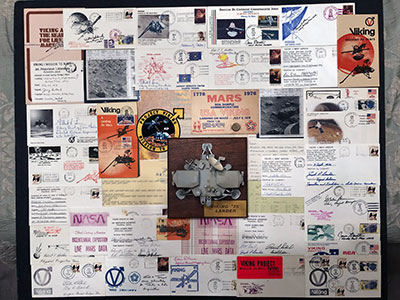 Included are signatures of the most influential scientists on the Viking team, such as noted biologist Norman Horowitz of Cal Tech, top scientist Gilbert Levin, world-renowned astronomer Carl Sagan, and biology team leader Harold Klein of "NASA Ames," just to name a few. Some of my favorite Viking covers depicted had been carried inside the Viking Mission Control and Computing Center at NASA's Jet Propulsion Laboratory in Pasadena, CA. The covers had been carried and stored inside the Viking flight control center by top officials while at their own console stations when monitoring and working the lander touchdowns. After being signed, many of the Viking cover signers included in their own hand, remarks and/or observations of the "real time" history-making achievements unfolding before their own eyes. As an end result, almost all of the "carried inside" covers received "on-site" landing day postal cancels at Pasadena. Other covers included have official Viking-related rubber stamp cachets added by NASA space centers at Kennedy, Langley, Goddard, and Ames. In addition, there are other rubber stamp and printed cachets by Martin Marietta Aerospace, RCA, TRW (though mostly unofficial) and an unusual NASA Third Century America Bicentennial Exposition cover issue with a "Live Mars Data" printout. In all, the Viking orbiters and landers returned more than 50,000 photo-images along with lots of information and data of the fourth planet from the sun in our solar system. The orbiters themselves mapped 97% of the Martian surface and the Viking 1 lander held the record for the longest surface mission (over 6 years or 2245 solar days), until that record was broken by the U.S. Opportunity Mars Rover in May 2010. It should also be noted that each Viking vehicle worked far beyond their design functions. The Viking 1 spacecraft also performed the first Martian soil sample analysis using its robotic arm with a special "built-in" biological laboratory. While it found no direct traces of Martian life, Viking 1 did help to better characterize Mars as a cold alien world. The Red Planet has volcanic soil, along with a thin dry carbon dioxide atmosphere, and a striking evidence for ancient river beds and vast flooding. But hopes of finding life on Mars, however, were not completely dashed out as first thought. Since the landings, there has been a detailed close-up study look from all the Martian space probe biological and other related scientific experiments to date. But those additional studies, mostly by a new generation of Mars scientists, are controversial, even though more is being understood about microbial activity on the red sands of Mars. |
onesmallstep
Member Posts: 1313
From: Staten Island, New York USA
Registered: Nov 2007
|
 posted 03-13-2020 03:52 PM
posted 03-13-2020 03:52 PM
   
Nice post with your covers and ephemera, Ken! I too remember those heady days in the 70s with the last Apollo flights; Skylab; ASTP and the Pioneers, Voyagers and Vikings exploring the planets. The thing that strikes me now is how primitive and "analog" the information was shared from the missions. I listened to the TV and read the papers, but you had to wait days if not weeks for a comprehensive report and photos to be issued (I still have some Voyager Mission Status Bulletins somewhere). Now, of course, everything is available at the touch of a finger or swipe on your PC or iPhone. For Viking, I was living on Miami Beach at the time, and remember getting on a bus for a long trip to Florida International Univ. to attend a conference on the latest Mars results. I, also a college student at the time, was happy to get any scrap of information "hot off the press." Now the event would be live-streamed or even taped for later play-on your electronic device. |
Ken Havekotte
Member Posts: 2979
From: Merritt Island, Florida, Brevard
Registered: Mar 2001
|
 posted 04-10-2020 02:22 PM
posted 04-10-2020 02:22 PM
   
Going back to the first post of this topic forum, while sorting through thousands of space covers during this "stay home" period because of the virus outbreak, I was able to locate another early Viking Mars cover that can be seen below. It pertains to the SPED (Supersonic Planetary Entry Decelerator) mars chute test of a "parasol popping" experiment study at Wallops Islands, VA, on Oct. 9, 1970. This was the first known pre-Viking launch cover to appear on the space cover market in 1970. The airmail cover below is for the same test event, but it has a different cachet and with a hand cancel from the Wallops eastern coast launch site. The cover was produced by Andromeda with this issue being Cover No. 18 of that space cover firm. While we did know of the same SPED test cover event by Ed Hacker of Centennial Covers of Huntsville, AL, this makes a second known cover for it by another space cover producer. Still, though, are there no other Viking events in 1969-71 out there? 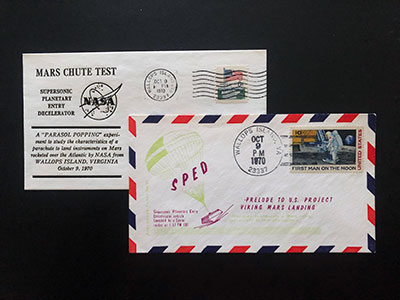 |
Philip
Member Posts: 5999
From: Brussels, Belgium
Registered: Jan 2001
|
 posted 04-11-2020 05:38 AM
posted 04-11-2020 05:38 AM
   
Interesting, thanks for sharing! | |
Contact Us | The Source for Space History & Artifacts
Copyright 2020 collectSPACE.com All rights reserved.

Ultimate Bulletin Board 5.47a
|
|

|
 advertisement advertisement

|
















